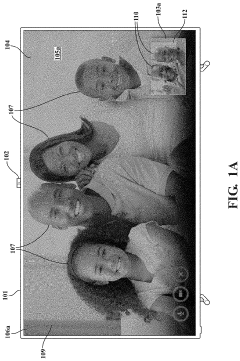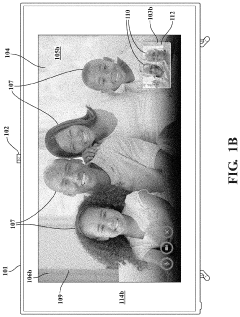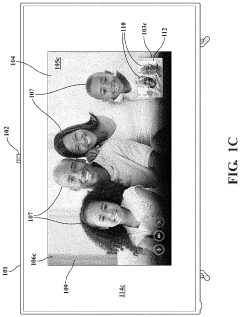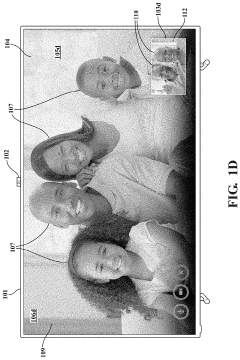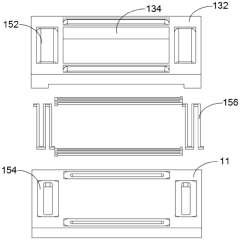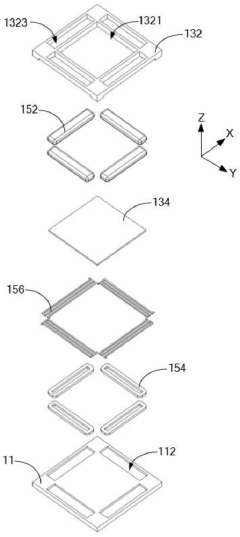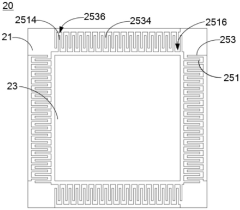ULED for Home Theaters: Best Practices
JUN 23, 20259 MIN READ
Generate Your Research Report Instantly with AI Agent
Patsnap Eureka helps you evaluate technical feasibility & market potential.
ULED Technology Evolution
ULED (Ultra Light Emitting Diode) technology has undergone significant evolution since its inception, revolutionizing the home theater experience. The journey of ULED began with the development of LED technology, which laid the foundation for more advanced display solutions. As LED technology matured, manufacturers sought ways to enhance picture quality, leading to the birth of ULED.
The early stages of ULED development focused on improving brightness and contrast ratios. Engineers worked tirelessly to create panels capable of producing deeper blacks and more vibrant colors. This phase saw the introduction of local dimming techniques, which allowed for more precise control over backlight zones, resulting in improved contrast and reduced light bleeding.
As ULED technology progressed, attention shifted towards color accuracy and gamut expansion. Manufacturers invested heavily in quantum dot technology, which enabled ULED displays to reproduce a wider range of colors with greater precision. This advancement significantly enhanced the viewing experience, particularly for HDR content, bringing cinema-quality visuals to home theaters.
The next major milestone in ULED evolution was the integration of artificial intelligence and machine learning algorithms. These smart technologies allowed for real-time image processing and optimization, adapting to different content types and viewing conditions. AI-driven features such as scene recognition and dynamic contrast adjustment became standard in high-end ULED displays, further elevating the home theater experience.
Recent years have seen a focus on energy efficiency and environmental sustainability in ULED development. Manufacturers have made strides in reducing power consumption without compromising picture quality, addressing growing consumer concerns about energy usage and environmental impact. This has led to the development of more eco-friendly ULED panels that maintain exceptional performance while minimizing their carbon footprint.
The latest advancements in ULED technology have centered around improving motion handling and reducing input lag. With the rise of gaming and fast-paced content, display manufacturers have invested in developing ULED panels with higher refresh rates and faster response times. These improvements have made ULED displays increasingly versatile, catering to both cinephiles and gamers alike.
Looking ahead, the future of ULED technology promises even more exciting developments. Research is underway to create micro-LED displays, which could potentially offer even better picture quality and energy efficiency. Additionally, efforts are being made to improve viewing angles and reduce reflections, addressing some of the remaining challenges in ULED technology for home theaters.
The early stages of ULED development focused on improving brightness and contrast ratios. Engineers worked tirelessly to create panels capable of producing deeper blacks and more vibrant colors. This phase saw the introduction of local dimming techniques, which allowed for more precise control over backlight zones, resulting in improved contrast and reduced light bleeding.
As ULED technology progressed, attention shifted towards color accuracy and gamut expansion. Manufacturers invested heavily in quantum dot technology, which enabled ULED displays to reproduce a wider range of colors with greater precision. This advancement significantly enhanced the viewing experience, particularly for HDR content, bringing cinema-quality visuals to home theaters.
The next major milestone in ULED evolution was the integration of artificial intelligence and machine learning algorithms. These smart technologies allowed for real-time image processing and optimization, adapting to different content types and viewing conditions. AI-driven features such as scene recognition and dynamic contrast adjustment became standard in high-end ULED displays, further elevating the home theater experience.
Recent years have seen a focus on energy efficiency and environmental sustainability in ULED development. Manufacturers have made strides in reducing power consumption without compromising picture quality, addressing growing consumer concerns about energy usage and environmental impact. This has led to the development of more eco-friendly ULED panels that maintain exceptional performance while minimizing their carbon footprint.
The latest advancements in ULED technology have centered around improving motion handling and reducing input lag. With the rise of gaming and fast-paced content, display manufacturers have invested in developing ULED panels with higher refresh rates and faster response times. These improvements have made ULED displays increasingly versatile, catering to both cinephiles and gamers alike.
Looking ahead, the future of ULED technology promises even more exciting developments. Research is underway to create micro-LED displays, which could potentially offer even better picture quality and energy efficiency. Additionally, efforts are being made to improve viewing angles and reduce reflections, addressing some of the remaining challenges in ULED technology for home theaters.
Home Theater Market Trends
The home theater market has been experiencing significant growth and transformation in recent years, driven by technological advancements and changing consumer preferences. As more people seek immersive entertainment experiences within the comfort of their homes, the demand for high-quality home theater systems has surged. This trend has been further accelerated by the global pandemic, which led to increased time spent at home and a greater focus on creating premium entertainment spaces.
One of the key factors driving market growth is the increasing adoption of 4K and 8K resolution displays, which offer superior picture quality and enhance the overall viewing experience. The proliferation of streaming services and the availability of high-quality content have also contributed to the rising demand for advanced home theater setups. Consumers are increasingly willing to invest in premium audio-visual equipment to replicate the cinema experience at home.
The market has seen a shift towards more integrated and smart home theater systems. Voice-controlled devices and AI-powered systems are becoming increasingly popular, allowing users to control their entire home theater setup with simple voice commands. This integration extends to other smart home devices, creating a seamless and interconnected entertainment ecosystem.
Another notable trend is the growing popularity of short-throw and ultra-short-throw projectors. These devices offer large screen experiences without requiring significant space, making them ideal for smaller living areas. They provide an alternative to traditional large-screen TVs and are particularly appealing to urban dwellers with space constraints.
The soundbar segment has also seen substantial growth, with consumers seeking simplified yet high-quality audio solutions. Advanced soundbars with features like Dolby Atmos and DTS:X are gaining traction, offering immersive audio experiences without the complexity of traditional multi-speaker setups.
Sustainability and energy efficiency have become important considerations in the home theater market. Consumers are increasingly looking for eco-friendly options, leading to the development of more energy-efficient displays and audio systems. This trend aligns with broader consumer preferences for environmentally responsible products.
The market is also witnessing a rise in customized and themed home theater installations. Homeowners are investing in creating unique entertainment spaces that reflect their personal style and preferences, ranging from classic cinema-inspired designs to futuristic setups.
As the home theater market continues to evolve, manufacturers are focusing on innovation to meet consumer demands for higher quality, greater convenience, and enhanced integration. The future of the market looks promising, with continued growth expected as technology advances and consumer interest in premium home entertainment experiences remains strong.
One of the key factors driving market growth is the increasing adoption of 4K and 8K resolution displays, which offer superior picture quality and enhance the overall viewing experience. The proliferation of streaming services and the availability of high-quality content have also contributed to the rising demand for advanced home theater setups. Consumers are increasingly willing to invest in premium audio-visual equipment to replicate the cinema experience at home.
The market has seen a shift towards more integrated and smart home theater systems. Voice-controlled devices and AI-powered systems are becoming increasingly popular, allowing users to control their entire home theater setup with simple voice commands. This integration extends to other smart home devices, creating a seamless and interconnected entertainment ecosystem.
Another notable trend is the growing popularity of short-throw and ultra-short-throw projectors. These devices offer large screen experiences without requiring significant space, making them ideal for smaller living areas. They provide an alternative to traditional large-screen TVs and are particularly appealing to urban dwellers with space constraints.
The soundbar segment has also seen substantial growth, with consumers seeking simplified yet high-quality audio solutions. Advanced soundbars with features like Dolby Atmos and DTS:X are gaining traction, offering immersive audio experiences without the complexity of traditional multi-speaker setups.
Sustainability and energy efficiency have become important considerations in the home theater market. Consumers are increasingly looking for eco-friendly options, leading to the development of more energy-efficient displays and audio systems. This trend aligns with broader consumer preferences for environmentally responsible products.
The market is also witnessing a rise in customized and themed home theater installations. Homeowners are investing in creating unique entertainment spaces that reflect their personal style and preferences, ranging from classic cinema-inspired designs to futuristic setups.
As the home theater market continues to evolve, manufacturers are focusing on innovation to meet consumer demands for higher quality, greater convenience, and enhanced integration. The future of the market looks promising, with continued growth expected as technology advances and consumer interest in premium home entertainment experiences remains strong.
ULED Challenges in Home Theaters
ULED technology, while offering significant advancements in display quality for home theaters, faces several challenges in its implementation and widespread adoption. One of the primary obstacles is the high cost associated with ULED panels, which currently limits its accessibility to a broader consumer base. The intricate manufacturing process and advanced materials required contribute to this elevated price point, making it difficult for ULED to compete with more established technologies in terms of affordability.
Another significant challenge lies in the power consumption of ULED displays. While improvements have been made, ULED screens still tend to consume more energy compared to traditional LED or OLED alternatives. This increased power draw not only impacts energy bills but also raises concerns about environmental sustainability, a growing consideration for both consumers and manufacturers in the home theater market.
Heat management presents a further technical hurdle for ULED in home theater applications. The high brightness levels achievable by ULED panels generate considerable heat, necessitating advanced cooling solutions. Balancing the need for effective heat dissipation with the desire for slim, aesthetically pleasing designs poses a significant engineering challenge.
Content availability optimized for ULED's capabilities is another area of concern. While ULED displays can offer superior color reproduction and contrast ratios, there is a limited amount of content specifically mastered to take full advantage of these capabilities. This discrepancy between display technology and available content can lead to a suboptimal viewing experience, potentially diminishing the perceived value of ULED for home theater enthusiasts.
Compatibility issues with existing home theater systems and standards also present challenges. As ULED technology continues to evolve, ensuring seamless integration with current audio-visual equipment, content delivery systems, and emerging standards like HDMI 2.1 is crucial for widespread adoption in home theater setups.
Lastly, consumer education and perception pose significant hurdles. Many potential buyers may not fully understand the benefits of ULED over other display technologies, leading to hesitation in investing in this premium option. Overcoming misconceptions and effectively communicating the value proposition of ULED for home theaters requires concerted marketing efforts and clear, demonstrable advantages in real-world viewing scenarios.
Addressing these challenges will be critical for the successful integration of ULED technology in home theaters. As the technology matures and economies of scale come into play, many of these obstacles may be mitigated, potentially paving the way for ULED to become a dominant force in high-end home entertainment displays.
Another significant challenge lies in the power consumption of ULED displays. While improvements have been made, ULED screens still tend to consume more energy compared to traditional LED or OLED alternatives. This increased power draw not only impacts energy bills but also raises concerns about environmental sustainability, a growing consideration for both consumers and manufacturers in the home theater market.
Heat management presents a further technical hurdle for ULED in home theater applications. The high brightness levels achievable by ULED panels generate considerable heat, necessitating advanced cooling solutions. Balancing the need for effective heat dissipation with the desire for slim, aesthetically pleasing designs poses a significant engineering challenge.
Content availability optimized for ULED's capabilities is another area of concern. While ULED displays can offer superior color reproduction and contrast ratios, there is a limited amount of content specifically mastered to take full advantage of these capabilities. This discrepancy between display technology and available content can lead to a suboptimal viewing experience, potentially diminishing the perceived value of ULED for home theater enthusiasts.
Compatibility issues with existing home theater systems and standards also present challenges. As ULED technology continues to evolve, ensuring seamless integration with current audio-visual equipment, content delivery systems, and emerging standards like HDMI 2.1 is crucial for widespread adoption in home theater setups.
Lastly, consumer education and perception pose significant hurdles. Many potential buyers may not fully understand the benefits of ULED over other display technologies, leading to hesitation in investing in this premium option. Overcoming misconceptions and effectively communicating the value proposition of ULED for home theaters requires concerted marketing efforts and clear, demonstrable advantages in real-world viewing scenarios.
Addressing these challenges will be critical for the successful integration of ULED technology in home theaters. As the technology matures and economies of scale come into play, many of these obstacles may be mitigated, potentially paving the way for ULED to become a dominant force in high-end home entertainment displays.
Current ULED Implementation
01 ULED display panel structure
ULED display panels incorporate innovative structural designs to enhance performance and efficiency. These designs may include specialized pixel arrangements, improved light-emitting layers, and optimized electrode configurations. Such advancements contribute to better color reproduction, increased brightness, and improved energy efficiency in ULED displays.- ULED display panel structure: ULED (Ultra Light Emitting Diode) display panels incorporate advanced structures to enhance performance and efficiency. These structures may include specialized pixel arrangements, improved light-emitting layers, and optimized electrode configurations. The design aims to achieve better color reproduction, higher brightness, and increased energy efficiency compared to traditional LED displays.
- ULED backlight module design: ULED technology is applied in backlight modules for displays, offering improved brightness and uniformity. These modules may feature innovative light guide plates, reflective structures, and optical films to enhance light distribution and reduce power consumption. The design focuses on achieving thinner profiles and better local dimming capabilities for HDR performance.
- ULED driving and control methods: Advanced driving and control methods are developed for ULED displays to optimize performance and reduce power consumption. These may include pulse width modulation techniques, dynamic refresh rate adjustments, and intelligent brightness control algorithms. The methods aim to enhance image quality, reduce motion blur, and extend the lifespan of ULED displays.
- ULED color management and gamut enhancement: ULED technology incorporates sophisticated color management systems and gamut enhancement techniques. These may include advanced color filters, quantum dot materials, and color processing algorithms. The goal is to achieve wider color gamuts, more accurate color reproduction, and improved HDR performance in displays.
- ULED manufacturing processes and materials: Innovative manufacturing processes and materials are developed for ULED production to improve efficiency and reduce costs. These may include new deposition techniques, novel semiconductor materials, and advanced packaging methods. The focus is on enhancing yield rates, increasing production scalability, and improving the overall quality of ULED displays.
02 ULED backlight technology
ULED backlight technology focuses on enhancing the illumination system behind the display panel. This may involve the use of advanced LED arrangements, light guide plates, and optical films to achieve uniform brightness distribution, improved contrast, and reduced power consumption. These innovations contribute to the overall picture quality and energy efficiency of ULED displays.Expand Specific Solutions03 ULED color management and enhancement
Color management and enhancement techniques in ULED displays aim to improve color accuracy, gamut, and overall visual experience. This may include advanced color filtering technologies, quantum dot integration, and sophisticated color processing algorithms. These innovations result in more vibrant and lifelike images on ULED screens.Expand Specific Solutions04 ULED driver circuits and control systems
ULED displays employ advanced driver circuits and control systems to optimize performance and power efficiency. These may include innovative voltage regulation techniques, precise current control mechanisms, and intelligent dimming algorithms. Such systems ensure stable operation, uniform brightness, and extended lifespan of ULED panels.Expand Specific Solutions05 ULED manufacturing processes and materials
Advancements in ULED manufacturing processes and materials focus on improving production efficiency and display quality. This may involve novel deposition techniques, innovative electrode materials, and enhanced encapsulation methods. These developments contribute to the production of more durable, higher-performing ULED displays with improved yield rates.Expand Specific Solutions
Key ULED Manufacturers
The ULED (Ultra LED) technology for home theaters is in a growth phase, with increasing market size and technological advancements. The global market for high-end display technologies is expanding, driven by consumer demand for immersive viewing experiences. Technologically, ULED is maturing rapidly, with key players like Samsung Electronics, LG Electronics, and BOE Technology Group leading innovation. These companies are investing heavily in R&D to improve picture quality, energy efficiency, and overall performance. Other significant contributors include Hisense Visual Technology and TCL China Star Optoelectronics, who are actively developing competitive ULED solutions. The technology's maturity is evident in the diverse range of products available, but there's still room for significant improvements in areas such as color accuracy, contrast ratios, and panel longevity.
Samsung Electronics Co., Ltd.
Technical Solution: Samsung's ULED (Ultra LED) technology for home theaters combines Quantum Dot technology with advanced local dimming techniques. Their approach uses a layer of quantum dots to enhance color accuracy and brightness, while mini-LED backlighting allows for precise control of local dimming zones. This results in deeper blacks, brighter highlights, and improved contrast ratios. Samsung also incorporates AI-powered upscaling to enhance lower resolution content for 4K and 8K displays, ensuring optimal picture quality regardless of the source material.
Strengths: Superior color accuracy and brightness, excellent contrast ratios, and advanced AI upscaling. Weaknesses: Potentially higher cost compared to traditional LED technology, and complexity in manufacturing process.
BOE Technology Group Co., Ltd.
Technical Solution: BOE's approach to ULED technology for home theaters centers on their Advanced Display System (ADS) technology. This system combines high-resolution panels with quantum dot technology and mini-LED backlighting. BOE's ULED displays feature thousands of local dimming zones for precise contrast control, along with their proprietary image processing algorithms that enhance detail and reduce noise. They also incorporate high refresh rates (up to 120Hz) and wide color gamut support for improved motion handling and color accuracy. BOE's ULED technology aims to deliver HDR performance comparable to OLED while maintaining the brightness advantages of LED technology.
Strengths: High brightness capabilities, good HDR performance, and competitive pricing. Weaknesses: May not match the absolute black levels of OLED technology, and potential for some blooming in high-contrast scenes.
ULED Innovations for Home Theaters
Systems and methods for enhancing television display for video conferencing and video watch party applications
PatentPendingUS20220270556A1
Innovation
- Utilizing the pixels of a television display, such as LCD or OLED TVs, to selectively illuminate subjects by adjusting pixel parameters like luminance and RGB values, and creating a border of white pixels to provide additional lighting, allowing for improved illumination without the need for external lighting systems.
ULED packaging structure and imaging device
PatentPendingCN116741909A
Innovation
- By introducing a drive reset component into the uLED packaging structure, the drive frame moves in the second direction relative to the substrate to provide a reset force, using the persistence of vision of the human eye to reduce the impact of unlit uLEDs, stabilize imaging quality, and achieve a compact structure. change.
ULED Energy Efficiency
ULED (Ultra Light Emitting Diode) technology has made significant strides in energy efficiency for home theater systems. The latest advancements in ULED displays have resulted in substantial improvements in power consumption without compromising picture quality or performance.
One of the key factors contributing to ULED's energy efficiency is its advanced local dimming technology. By precisely controlling the backlight in specific zones, ULED displays can achieve deeper blacks and higher contrast ratios while simultaneously reducing power consumption. This targeted approach to illumination ensures that energy is only used where it's needed, resulting in overall lower power requirements.
Another important aspect of ULED energy efficiency is the use of quantum dot technology. Quantum dots enhance color accuracy and brightness, allowing ULED displays to produce vivid and lifelike images with less power input. This technology enables displays to achieve a wider color gamut and higher peak brightness levels while maintaining energy efficiency.
ULED displays also incorporate sophisticated power management systems that optimize energy usage based on content and viewing conditions. These systems can dynamically adjust brightness and contrast levels in real-time, reducing power consumption during darker scenes or when ambient light levels are low. This adaptive approach ensures that energy is not wasted on unnecessary illumination.
The implementation of advanced LED drivers and power supply units in ULED displays further contributes to their energy efficiency. These components are designed to minimize power loss during voltage conversion and distribution, resulting in more efficient overall power utilization.
Moreover, ULED technology often includes energy-saving modes that can be activated by users or automatically engaged based on usage patterns. These modes can reduce power consumption during periods of inactivity or when full display capabilities are not required, further enhancing the overall energy efficiency of home theater systems.
Recent developments in ULED panel design have also led to improvements in thermal management. By effectively dissipating heat, these displays can operate at lower temperatures, which not only extends the lifespan of the components but also reduces the energy required for cooling systems.
As ULED technology continues to evolve, manufacturers are exploring new materials and manufacturing processes to further enhance energy efficiency. This includes research into more efficient phosphors, improved LED structures, and advanced optical films that can maximize light output while minimizing power input.
One of the key factors contributing to ULED's energy efficiency is its advanced local dimming technology. By precisely controlling the backlight in specific zones, ULED displays can achieve deeper blacks and higher contrast ratios while simultaneously reducing power consumption. This targeted approach to illumination ensures that energy is only used where it's needed, resulting in overall lower power requirements.
Another important aspect of ULED energy efficiency is the use of quantum dot technology. Quantum dots enhance color accuracy and brightness, allowing ULED displays to produce vivid and lifelike images with less power input. This technology enables displays to achieve a wider color gamut and higher peak brightness levels while maintaining energy efficiency.
ULED displays also incorporate sophisticated power management systems that optimize energy usage based on content and viewing conditions. These systems can dynamically adjust brightness and contrast levels in real-time, reducing power consumption during darker scenes or when ambient light levels are low. This adaptive approach ensures that energy is not wasted on unnecessary illumination.
The implementation of advanced LED drivers and power supply units in ULED displays further contributes to their energy efficiency. These components are designed to minimize power loss during voltage conversion and distribution, resulting in more efficient overall power utilization.
Moreover, ULED technology often includes energy-saving modes that can be activated by users or automatically engaged based on usage patterns. These modes can reduce power consumption during periods of inactivity or when full display capabilities are not required, further enhancing the overall energy efficiency of home theater systems.
Recent developments in ULED panel design have also led to improvements in thermal management. By effectively dissipating heat, these displays can operate at lower temperatures, which not only extends the lifespan of the components but also reduces the energy required for cooling systems.
As ULED technology continues to evolve, manufacturers are exploring new materials and manufacturing processes to further enhance energy efficiency. This includes research into more efficient phosphors, improved LED structures, and advanced optical films that can maximize light output while minimizing power input.
ULED Content Optimization
Content optimization plays a crucial role in maximizing the visual impact of ULED technology for home theaters. To achieve optimal results, it is essential to focus on several key aspects of content creation and processing.
High Dynamic Range (HDR) content is paramount for ULED displays. Content creators should leverage the full potential of HDR by capturing and preserving a wide range of luminance levels. This involves careful attention to highlight and shadow details, ensuring that both bright and dark areas of scenes are rendered with exceptional clarity and depth.
Color grading for ULED displays requires a nuanced approach. Content should be mastered to take advantage of the expanded color gamut offered by ULED technology. This involves precise color mapping to ensure accurate and vibrant color reproduction across the entire spectrum, with particular attention to subtle gradations and skin tones.
Resolution optimization is another critical factor. While ULED displays often support 4K or even 8K resolutions, content creators must balance detail with efficient compression techniques. Utilizing advanced codecs and encoding methods can help maintain high image quality while managing file sizes and streaming bandwidth requirements.
Motion handling is a key consideration for ULED content. High frame rates, such as 60fps or 120fps, can significantly enhance the smoothness of motion, particularly in fast-paced scenes or sports content. However, content creators must carefully consider the intended viewing experience and the capabilities of target display devices.
Audio optimization, while not directly related to the visual aspects of ULED, is crucial for creating an immersive home theater experience. Content should be mixed and mastered for multi-channel audio systems, with attention to spatial audio technologies that complement the visual fidelity of ULED displays.
Content creators should also consider the unique characteristics of ULED technology when designing visual elements. This includes leveraging the high contrast ratios and local dimming capabilities to create striking visual compositions that enhance depth perception and overall image impact.
Lastly, it is important to implement robust metadata management for ULED content. This includes accurate HDR metadata, color space information, and display-specific optimizations that enable ULED displays to automatically adjust their settings for optimal viewing experiences across various content types and lighting conditions.
High Dynamic Range (HDR) content is paramount for ULED displays. Content creators should leverage the full potential of HDR by capturing and preserving a wide range of luminance levels. This involves careful attention to highlight and shadow details, ensuring that both bright and dark areas of scenes are rendered with exceptional clarity and depth.
Color grading for ULED displays requires a nuanced approach. Content should be mastered to take advantage of the expanded color gamut offered by ULED technology. This involves precise color mapping to ensure accurate and vibrant color reproduction across the entire spectrum, with particular attention to subtle gradations and skin tones.
Resolution optimization is another critical factor. While ULED displays often support 4K or even 8K resolutions, content creators must balance detail with efficient compression techniques. Utilizing advanced codecs and encoding methods can help maintain high image quality while managing file sizes and streaming bandwidth requirements.
Motion handling is a key consideration for ULED content. High frame rates, such as 60fps or 120fps, can significantly enhance the smoothness of motion, particularly in fast-paced scenes or sports content. However, content creators must carefully consider the intended viewing experience and the capabilities of target display devices.
Audio optimization, while not directly related to the visual aspects of ULED, is crucial for creating an immersive home theater experience. Content should be mixed and mastered for multi-channel audio systems, with attention to spatial audio technologies that complement the visual fidelity of ULED displays.
Content creators should also consider the unique characteristics of ULED technology when designing visual elements. This includes leveraging the high contrast ratios and local dimming capabilities to create striking visual compositions that enhance depth perception and overall image impact.
Lastly, it is important to implement robust metadata management for ULED content. This includes accurate HDR metadata, color space information, and display-specific optimizations that enable ULED displays to automatically adjust their settings for optimal viewing experiences across various content types and lighting conditions.
Unlock deeper insights with Patsnap Eureka Quick Research — get a full tech report to explore trends and direct your research. Try now!
Generate Your Research Report Instantly with AI Agent
Supercharge your innovation with Patsnap Eureka AI Agent Platform!
